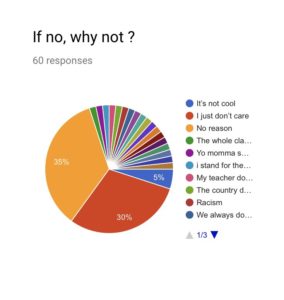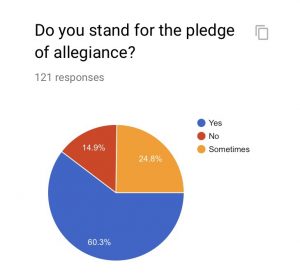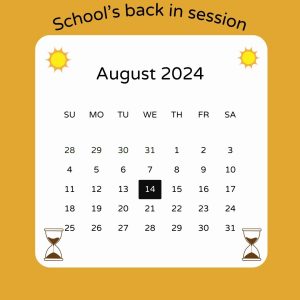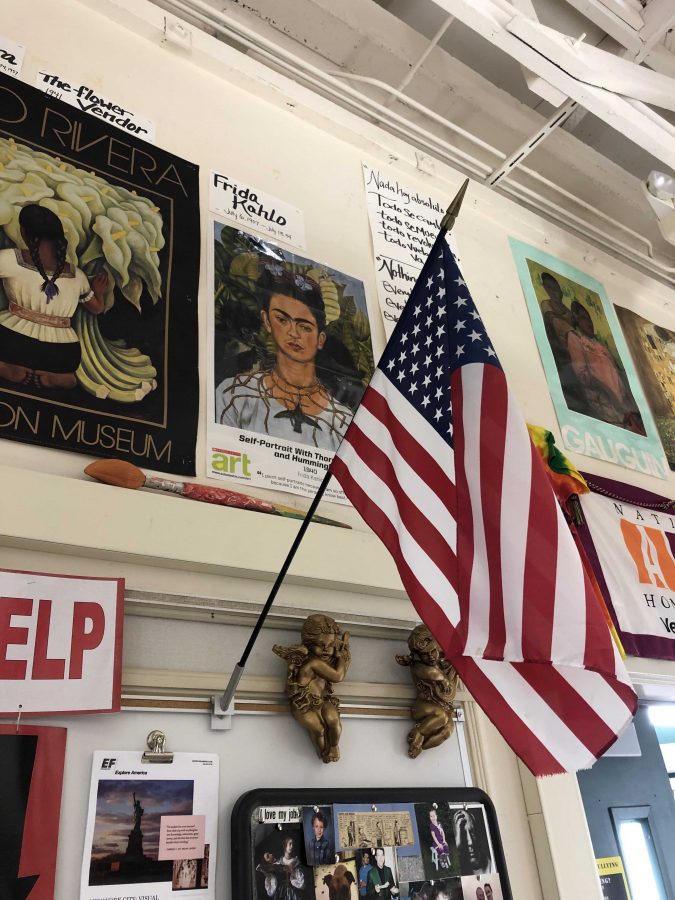Since kindergarten, students across the country have stood up every single morning, placed their hand across their hearts, and recited the Pledge of Allegiance. They have been taught that rehearsing these 31 words is a sign of reverence and admiration for our country. It is a chance to pay respect to the people before us who have fought and served. It is a moment to think about our history and loyalty to the place we call home. But what does the pledge really means, and why have we been saying it for over 100 years?

The origins of the pledge take place in 1892, when author Francis Bellamy was called upon to create an oath in celebration of 400 years since Columbus’s “discovery” of America. Bellamy’s pledge was published in the “Youth’s Companion” magazine, and was soon adopted by classrooms all throughout the country. Since then, the pledge has undergone adaptations–including the addition of “under God”– and has been involved in several legal disputes.
After learning about the history of the pledge, I was still curious as to what it really means to stand? In recent days, I have found myself both standing, reciting the pledge and also sitting, ignoring the salute that plays across the intercom. I have asked myself what it means to stand, or to not stand, and the truth is, I don’t know. Do I sit because it isn’t cool to say the pledge? Do I stand because I love my country?
In a survey of VHS 121 students at Ventura, over 60 percent said they stand for the pledge each morning. This result was surprising to me, considering I have seen classes where more than half of the students remain seated. Of the 14.9 percent that stated they did not stand for the pledge, 35 percent said there was “no reason” for not standing. This is understandable,

considering the message behind the pledge has become so convoluted today. With national controversy including Kaepernick’s kneeling during the National Anthem, as well as issues concerning race, immigration, and rights, it is easy to forget the origins of the pledge, and why we continue to say it today. It is clear that there are very different feelings surrounding the pledge.

Senior Leo Cabello, feels very passionate about reciting the pledge, he informed me that whenever he says it, he “take[s] the opportunity to say it loudly and proudly.” There are also many students who are indifferent, 30 percent of the students who reported they sat during the pledge said they “just didn’t care” to stand. While I continue to contemplate if I should or should not stand. When I do stand, I find myself somewhat embarrassed, as if it’s weird to stand up and recite words of admiration for my country. Of the students that do stand, they often mumble or refrain from actually saying the words. The feeling of judgement overcomes the feeling of a need to stand and salute the flag. Similarly, most students are encouraged by their classmates. When one person stands, it creates a wave effect that inspires others to stand. While a person in class may sit, and that makes their friends, and other classmates feel the need to sit as well.
Teachers have a different role when it comes to the pledge. It is up to them to first allow the intercom to play in their classrooms, and then they serve as role models. Do the stand? Sit? Encourage their students to stand? Question students when they choose to sit? History teacher Mark Schmidt states reciting the pledge is as simple as “considering yourself a relatively loyal American citizen.” Similarly, art teacher Lauren Minadeo addresses the fact that there is controversy concerning standing or not standing, but she acknowledges that, “We are fortunate to be able to live here, whether or not we agree with current politics.” Minadeo continues by adding, “We are in a place where we are aloud to speak our mind, we are allowed to believe whatever we want to believe, and that makes [her] proud to stand for the pledge.” Other teachers such as Paul Togneri, have a different approach to the morning routine. His class stands for the Call to Colors, then the intercom is turned off and class is proceeded with Togneri claims, “I have already pledged that I will be an honorable, loyal, US citizen… I don’t need to make that promise every single day.”
After all, it is everyone’s right to decide whether or not they want to stand. And that makes me proud to live here. But will I stand for the pledge from now on? I’m not sure.
















Steve Strong • Sep 19, 2019 at 8:14 am
It is VUSD board policy that schools must perform a patriotic exercise each day!
In my opinion/experience most schools/classes choose to recite the pledge, the pledge requires about 14 seconds to complete, it is a very quick patriotic exercise. “I have heard teachers comment they don’t have time” Really?
I personally feel very proud of the USA, the Men and Women that have fought and died for the incredible gifts and freedoms we enjoy, standing and reciting a pledge of allegiance is the least we can do to honor all of our military, first responders… On 9/11 many students spoke of the lessons in their classes that day. I thought it ironic students from one class told me of a teacher that provided a lesson on 9/11 but the same students said that teacher regularly shuts off the intercom during the call to colors/pledge. The Supreme Court has ruled the pledge “Is not a prayer” and students do not have to recite the pledge, however standing and being respectful for 14 seconds should be observed! Red Skelton has a wonderful video on You Tube I show it each year to my students, when I introduce them to our classroom etiquette/expectations…
Teachers complain about student behavior often, here is an instant we can model pride, reverence, good manners and thanksgiving for privileges we all enjoy in the United States of America!